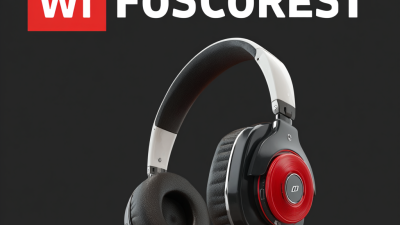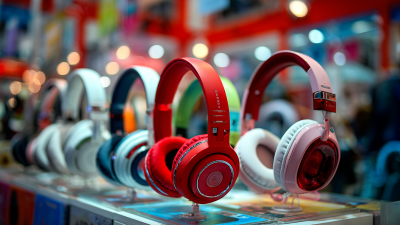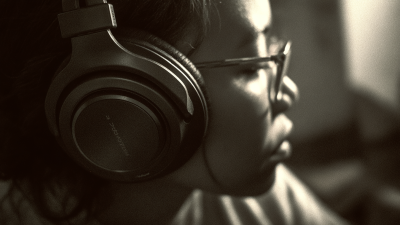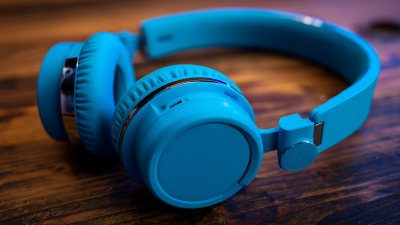Leave Your Message
-
Phone
-
E-mail
-
Whatsapp
As technology continues to evolve at an unprecedented pace, the way we experience sound is transforming dramatically. Among the innovations shaping the audio landscape, Blue Tooth Headphones stand out as a prime example of how wireless technology is enhancing sound quality and user convenience. The shift from traditional wired headphones to Bluetooth models not only liberates users from tangled cords but also opens up new avenues for sound enhancement, making high-fidelity audio accessible to a broader audience.

In this article, we will explore the future of sound quality through the lens of Bluetooth headphones, examining the cutting-edge technologies that are pushing the boundaries of audio excellence. From advancements in codec technology, which determines the audio compression and quality, to breakthroughs in driver designs and active noise cancellation, the current innovations promise a listening experience that is more immersive and personalized than ever before.
As we delve into the key features and emerging trends, we’ll also provide practical insights on how to choose the best Bluetooth headphones to suit individual needs, ensuring that every listener can unlock the full potential of modern audio technology.
The market for Bluetooth headphones has witnessed significant growth, with its size surpassing $60 billion in 2019. Projections indicate a compound annual growth rate (CAGR) of over 10% between 2020 and 2026, a trend driven primarily by the increasing penetration of smartphones and escalating consumer demand for high-fidelity audio. As headphones transition from being ancillary tools to essential lifestyle accessories, this "auditory consumption awakening" is reshaping consumer behavior. According to market reports, the truly wireless stereo (TWS) segment is expected to experience remarkable expansion, with its value projected to reach approximately $11.2 billion by 2033.
Additionally, the wireless audio device market is set to grow to $25.2 billion by 2033, further underscoring the shift towards seamless connectivity and immersive sound experiences. In 2024, the total volume of the Chinese headphone market is anticipated to reach 218 million units, reflecting a year-on-year growth of 7.6%. This burgeoning demand for Bluetooth headphones highlights the industry's shift toward catering to consumers who prioritize superior sound quality in their everyday lives. The synergy between advanced technology and changing consumer preferences presents exciting opportunities for further innovation in the audio accessory market.
The rapid advancement of Bluetooth headphone technology has paved the way for significant enhancements in sound quality, primarily driven by innovations in audio codec technology. Modern audio codecs, such as aptX, AAC, and LDAC, have revolutionized the way music is transmitted wirelessly. These codecs enable higher bit rates and improved compression techniques, allowing Bluetooth headphones to deliver audio that is richer and more detailed than ever before. Users can experience enhanced bass response, clearer highs, and an overall more immersive listening experience.
**Tips:** When choosing Bluetooth headphones, pay attention to the supported audio codecs. Headphones that support high-quality codecs like LDAC or aptX will provide a greater audio experience, especially for audiophiles. Always ensure that the source device, such as your smartphone or laptop, is also compatible with these codecs to fully enjoy the benefits.
Additionally, the introduction of new technologies such as adaptive audio streaming is set to further improve this landscape. Adaptive streaming adjusts the audio quality based on the strength of the Bluetooth connection, ensuring minimal dropouts or quality loss during playback. This capability means that whether you are on a crowded subway or a quiet room, your listening experience remains consistently high.
**Tips:** Consider investing in headphones with adaptive audio technology. This feature can significantly enhance your listening experience, particularly in varying environments, so you can enjoy your favorite tracks without interruptions.
| Audio Codec | Bitrate (kbps) | Latency (ms) | Supported Formats | Use Case |
|---|---|---|---|---|
| AAC | 256 | 30 | Stereo | Music Streaming |
| aptX | 352 | 40 | Stereo | Gaming |
| LDAC | 990 | 60 | Stereo, Mono | High-Resolution Audio |
| LHDC | 900 | 90 | Stereo | High-Resolution Audio, Streaming |
| SBC | 320 | 100 | Stereo | Basic Streaming |
Active Noise Cancellation (ANC) technology has significantly transformed the user experience of Bluetooth headphones by enhancing sound quality and providing an immersive listening environment. By utilizing advanced algorithms and sophisticated microphones, ANC headphones detect ambient noise and generate inverse sound waves to cancel it out. This process allows users to enjoy their favorite music or podcasts without the intrusion of external sounds, making them ideal for commuting or noisy environments.
Moreover, the impact of ANC extends beyond just eliminating background noise. It creates a more focused audio experience, allowing listeners to appreciate subtle details in their music, such as intricate instrumentals or vocal nuances. This improved sound quality fosters deeper engagement with audio content, as users can hear subtleties they might otherwise miss. As Bluetooth technology continues to evolve, the integration of better ANC systems promises to further elevate the listening experience, offering users a perfect balance between sound quality and convenience.
The rapid advancements in Bluetooth headphone technology have significantly transformed the landscape of sound quality and battery performance. One of the key factors in determining the overall user experience is battery life. Innovations in battery technology, such as the use of more efficient lithium-ion cells and adaptive power management systems, have enabled manufacturers to extend listening time while maintaining remarkable sound fidelity. As users demand longer playtime without the need for frequent charging, brands are rising to the challenge by integrating smart features that optimize energy consumption.
Tips for maximizing battery life in your Bluetooth headphones include turning off noise-cancellation features when they are not needed, keeping the volume at moderate levels, and disconnecting from devices when not in use. These small adjustments can contribute to prolonged usage time, enhancing your listening experience.
Moreover, the innovation in fast charging capabilities is changing user behavior. Many headphones now offer quick charge options that provide several hours of playtime from just a short charging period. This evolution not only offers convenience but also encourages users to fully utilize their devices throughout the day without the anxiety of running low on battery. Opting for headphones with these features can enhance your overall experience, ensuring that quality sound and user satisfaction go hand in hand.
The wireless audio technology market is on the brink of significant expansion, with projections indicating that the global true wireless earbuds market is expected to grow from $1.193 billion in 2025 to approximately $1.948 billion by 2034, driven by a compound annual growth rate (CAGR) of 5.6%. As consumer preferences shift towards high-quality audio experiences, innovations in Bluetooth headphone technology are set to redefine sound quality standards. In addition, the wireless smart doorbell market is forecasted to see notable growth, starting at $2.09 billion in 2025 and potentially reaching $3.83 billion by 2035, with a robust CAGR of 6.24%.
Tips: As you explore the future of sound quality in Bluetooth technology, consider the impact of AI on audio applications. The integration of AI is transforming how devices interact with users, moving from passive response to active perception. This technology not only enhances user experience but also opens doors to unparalleled audio clarity.
Moreover, it's crucial to stay updated with reports like the 2025 Technology Consumer Goods Trends Report, which identifies emerging markets as key growth drivers in the audio space. Keeping an eye on these trends will help consumers make informed decisions about their audio tech investments.






